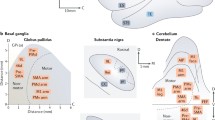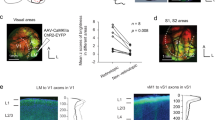Abstract
A major well-documented feature of cortical functional organization is the presence of prominent broadly tuned feed-forward inhibition in the input layer 4, in which local layer 4 inhibitory cells receive direct thalamocortical input and in turn suppress responses of neighboring layer 4 excitatory cells to their thalamocortical drive, thereby sharpening their receptive field properties. Here we review the evidence that the presence of broadly tuned feed-forward inhibition in layer 4 turns local layer 4 domains into functional analogs of Radial Basis Function networks, enabling layer 4 to contribute importantly to sensory information processing as a pluripotent function linearizer: i.e., it performs such a transform of afferent inputs to a cortical column that makes possible for neurons in the upper layers of the column to learn and perform their complex functions using primarily linear operations.
Feed-forward inhibition is subserved by fast-acting basket cells and slow-acting neurogliaform cells, which rely on GABAA and GABAB receptor-mediated inhibition, respectively. Their respective contributions can be observed by measuring tactile stimulus detection threshold using step vs. ramp vibrotactile stimuli. The static (step) threshold reflects basket-mediated inhibition, whereas the difference between the static and dynamic (ramp) thresholds reflects neurogliaform-mediated inhibition. Our feed-forward inhibition metric, which is based on the static and dynamic detection thresholds, can provide significant insight about the neurological health of the cortical circuitry, given that neurogliaform cells are engaged in on-demand energy homeostasis of cortical networks through their local release of insulin. For example, we have found this metric to be below normal in adolescents with autism spectrum disorder, but highly elevated in type 2 diabetes. Maladaptive feed-forward inhibition can have significant downstream implications for cortical information processing, and our metric can potentially be an effective means for evaluating a number of cortical abnormalities.
Similar content being viewed by others
References
Alonso JM, Swadlow HA (2005) Thalamocortical specificity and the synthesis of sensory cortical receptive fields. J Neurophysiol 94:26–32
Alonso JM, Usrey WM, Reid RC (2001) Rules of connectivity between geniculate cells and simple cells in cat primary visual cortex. J Neurosci 21:4002–4015
Anderson JC, Douglas RJ, Martin KAC et al (1994) Synaptic output of physiologically identified spiny stellate neurons in cat visual cortex. J Comp Neurol 341:16–24
Bohringer A, Schwabe L, Richter S et al (2008) Intranasal insulin attenuates the hypothalamic–pituitary–adrenal axis response to psychosocial stress. Psychoneuroendocrinology 33(10):1394–1400
Bonds AB (1989) Role of inhibition in the specification of orientation selectivity of cells in the cat striate cortex. Vis Neurosci 2:41–55
Brondino N, Fusar-Poli L, Panisi C et al (2016) Pharmacological modulation of GABA function in autism spectrum disorders: a systemic review of human studies. J Autism Dev Disord 46(3):825–839
Bruno RM, Simons DJ (2002) Feedforward mechanisms of excitatory and inhibitory cortical receptive fields. J Neurosci 22:10966–10975
Chapman CD, Frey WH II, Craft S et al (2013) Intranasal treatment of central nervous system dysfunction in humans. Pharm Res 30(10):2475–2484
Chung S, Ferster D (1998) Strength and orientation tuning of the thalamic input to simple cells revealed by electrically evoked cortical suppression. Neuron 20:1177–1189
Cruikshank SJ, Lewis TJ, Connors BW (2007) Synaptic basis for intense thalamocortical activation of feedforward inhibitory cells in neocortex. Nat Neurosci 10:462–468
Csajbok EA, Tamas G (2016) Cerebral cortex: a target and source of insulin? Diabetologia 59:1609–1615
DeAngelis GC, Robson JG, Ohzawa I et al (1992) The organization of suppression in receptive fields of neurons in the cat’s visual cortex. J Neurophysiol 68:144–163
DeAngelis GC, Ohzawa I, Freeman RD (1993) Spatiotemporal organization of simple-cell receptive fields in the cat’s striate cortex. I. General characteristics and postnatal development. J Neurophysiol 69:1091–1117
de la Monte SM (2013) Intranasal insulin therapy for cognitive impairment and neurodegeneration: current state of the art. Expert Opin Drug Deliv 10(12):1699–1709
Delaney E (2013) The relationship between traumatic stress, PTSD and cortisol. Naval Center for Combat & Operational Stress Control, San Diego
Dreher B (1972) Hypercomplex cells in the cat’s striate cortex. Invest Ophtalmol 11:355–356
Egede LE, Dismuke CE (2012) Serious psychological distress and diabetes: a review of the literature. Curr Psychiatry Rep 14(1):15–22
Egger V, Feldmeyer D, Sakmann B (1999) Coincidence detection and changes of synaptic efficacy in spiny stellate neurons in rat barrel cortex. Nat Neurosci 2:1098–1105
Favorov OV, Kursun O (2011) Neocortical layer 4 as a pluripotent function linearizer. J Neurophysiol 105:1342–1360
Felleman DJ, Van Essen DC (1991) Distributed hierarchical processing in the primate cerebral cortex. Cereb Cortex 1:1–47
Ferster D (1986) Orientation selectivity of synaptic potentials in neurons of cat primary visual cortex. J Neurosci 6:1284–1301
Ferster D, Chung S, Wheat H (1996) Orientation selectivity of thalamic input to simple cells of cat visual cortex. Nature 380:249–252
Francisco E, Favorov O, Tommerdahl M (2013) The role of cortical modularity in tactile information processing: an approach to measuring information processing deficits in autism. In: Fitzgerald M (ed) Recent advances in autism spectrum disorders, vol II. InTech. Rijeka, Croatia. doi:10.5772/54801
Freedman DJ, Miller EK (2007) Neural mechanisms of visual categorization: insights from neurophysiology. Neurosci Biobehav Rev 32:311–329
Furtado M, Katzman MA (2015) Neuroinflammatory pathways in anxiety, posttraumatic stress, and obsessive compulsive disorders. Psychiatry Res 229(1):37–48
Gardner JL, Anzai A, Ohzawa I et al (1999) Linear and nonlinear contributions to orientation tuning of simple cells in the cat’s striate cortex. Vis Neurosci 16:1115–1121
Grill-Spector K, Malach R (2004) The human visual cortex. Annu Rev Neurosci 27:649–677
Hirsch JA, Martinez LM, Pillai C et al (2003) Functionally distinct inhibitory neurons at the first stage of visual cortical processing. Nat Neurosci 6:1300–1308
Hubel DH, Wiesel TN (1962) Receptive fields, binocular interactions and functional architecture in the cat’s visual cortex. J Physiol Lond 160:106–154
Hull C, Isaacson JS, Scanziani M (2009) Postsynaptic mechanisms govern the differential excitation of cortical neurons by thalamic inputs. J Neurosci 29:9127–9136
Iwamura Y (1998) Hierarchical somatosensory processing. Curr Opin Neurobiol 8:522–528
Jones JP, Palmer LA (1987) The two-dimensional spatial structure of simple receptive fields in cat striate cortex. J Neurophysiol 58:1187–1211
Kourtzi Z, DiCarlo JJ (2006) Learning and neural plasticity in visual object recognition. Curr Opin Neurobiol 16:152–158
Kůrková V (2003) Universal approximators. In: Arbib MA (ed) The handbook of brain theory and neural networks, 2nd edn. MIT Press, Cambridge, pp 1180–1183
Kyriazi H, Carvell GE, Brumberg JC et al (1996) Quantitative effects of GABA and bicuculline methiodide on receptive field properties of neurons in real and simulated whisker barrels. J Neurophysiol 75:547–560
McNay EC, Recknagel AK (2011) Brain insulin signaling: a key component of cognitive processes and a potential basis for cognitive impairment in type 2 diabetes. Neurobiol Learn Mem 96:432–442
Miller KD, Pinto DJ, Simons DJ (2001) Processing in layer 4 of the neocortical circuit: new insights from visual and somatosensory cortex. Curr Opin Neurobiol 11:488–497
Molnár G, Faragó N, Kocsis Á et al (2014) GABAergic neurogliaform cells represent local sources of insulin in the cerebral cortex. J Neurosci 34(4):1133–1137
Movshon JA, Thompson ID, Tolhurst DJ (1978) Spatial and temporal contrast sensitivity on neurons in areas 17 and 18 of the cat’s visual cortex. J Physiol 283:101–120
Olah S, Fule M, Komlosi G et al (2009) Regulation of cortical microcircuits by unitary GABA-mediated volume transmission. Nature 461:1278–1282
Park J, Sandberg IW (1991) Universal approximation using radial-basis-function networks. Neural Comput 3:246–257
Porter JT, Johnson CK, Agmon A (2001) Diverse types of interneurons generate thalamus-evoked feed-forward inhibition in the mouse barrel cortex. J Neurosci 21:2699–2710
Purkayastha P, Malapati A, Yogeeswari P et al (2015) A review of GABA/glutamate pathway for therapeutic intervention of ASD and ADHD. Curr Med Chem 22(15):1850–1859
Puts N, Wodka E, Tommerdahl M et al (2014) Impaired tactile processing in children with austism spectrum disorder. J Neurophysiol 111(9):1803–1811
Puts N, Wodka E, Harris A et al (2016) Reduced GABA and altered somatosensory function in children with autism spectrum disorder. Autism Res. doi:10.1002/aur.1691
Rauschecker JP (1998) Cortical processing of complex sounds. Curr Opin Neurobiol 8:516–521
Rockland KS, Pandya DN (1979) Laminar origins and terminations of cortical connections of the occipital lobe in the rhesus monkey. Brain Res 179:3–20
Rose D, Blakemore C (1974) An analysis of orientation selectivity in the cat’s visual cortex. Exp Brain Res 20:1–17
Sáez I, Friedlander MJ (2009) Plasticity between neuronal pairs in layer 4 of visual cortex varies with synapse state. J Neurosci 29:15286–15298
Schölkopf B, Smola AJ (2002) Learning with Kernels. MIT Press, Cambridge
Sclar G, Freeman RD (1982) Orientation selectivity in the cat’s striate cortex is invariant with stimulus contrast. Exp Brain Res 46:457–461
Skottun BC, Valois RL, Grosof DH et al (1991) Classifying simple and complex cells on the basis of response modulation. Vis Res 31:1079–1086
Sun QQ, Huguenard JR, Prince DA (2006) Barrel cortex microcircuits: thalamocortical feedforward inhibition in spiny stellate cells is mediated by a small number of fast-spiking interneurons. J Neurosci 26:1219–1230
Sur M, Rubenstein JLR (2005) Patterning and plasticity of the cerebral cortex. Science 310:805–810
Swadlow HA (2002) Thalamocortical control of feed-forward inhibition in awake somatosensory “barrel” cortex. Philos Trans R Soc Lond Ser B Biol Sci 357:1717–1727
Swadlow HA (2003) Fast-spiking interneurons and feedforward inhibition in awake sensory neocortex. Cereb Cortex 13:25–32
Tamas G, Lorincz A, Simon A et al (2003) Identified sources and targets of slow inhibition in the neocortex. Science 299:1902–1905
Tarczy-Hornoch K, Martin KAC, Stratford KJ et al (1999) Intracortical excitation of spiny neurons in layer 4 of cat striate cortex in vitro. Cereb Cortex 9:833–843
Tavassoli T, Bellesheim K, Tommerdahl M et al (2015) Altered tactile processing in children with autism spectrum disorder. Autism Res 9:616–620
Tolhurst DJ, Thompson ID (1981) On the variety of spatial frequency selectivities shown by neurons in area 17 of the cat. Proc R Soc Lond B 213:183–199
Vidyasagar TR, Siguenza JA (1985) Relationship between orientation tuning and spatial frequency of cat area 17. Exp Brain Res 57:628–631
Zhang Z, Francisco E, Holden J et al (2011) Somatosensory information processing in the aging population. Front Aging Neurosci 3:18. doi:10.3389/fnagi.2011.00018
Acknowledgements
Partial support for this work was provided by the Office of Naval Research, Applied Research Associates, and by TUBITAK-1001 Research Project (Project ID: 114E178).
Author information
Authors and Affiliations
Corresponding author
Editor information
Editors and Affiliations
Rights and permissions
Copyright information
© 2017 Springer International Publishing Switzerland
About this chapter
Cite this chapter
Favorov, O.V., Kursun, O., Tommerdahl, M. (2017). Role of Feed-Forward Inhibition in Neocortical Information Processing: Implications for Neurological Disorders. In: Opris, I., Casanova, M.F. (eds) The Physics of the Mind and Brain Disorders. Springer Series in Cognitive and Neural Systems, vol 11. Springer, Cham. https://doi.org/10.1007/978-3-319-29674-6_17
Download citation
DOI: https://doi.org/10.1007/978-3-319-29674-6_17
Published:
Publisher Name: Springer, Cham
Print ISBN: 978-3-319-29672-2
Online ISBN: 978-3-319-29674-6
eBook Packages: Biomedical and Life SciencesBiomedical and Life Sciences (R0)




